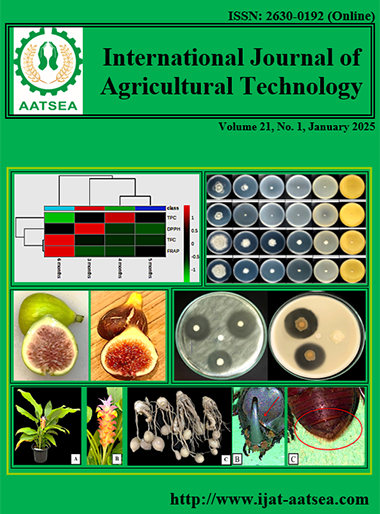Genetic diversity of common figs (Ficus carica) cultivated in Thailand determined by 18S ribosomal RNA sequence
Main Article Content
Abstract
The common fig (Ficus carica) is an economically important fruit crop widely consumed worldwide. In this study, the genetic diversity of 5 varieties of figs are commonly grown in Thailand as Longue d’Aout, Col De Dama Blanca, Weihai, Iraqi, and White Israel which showed highly similar 18S rRNA, and similar to 2 other related species of Ficus palmata and Ficus johannis. The only exception is shown in the Iraqi fig, which possessed 2 positions of single nucleotide substitutions (C to T). Interestingly, Iraqi is found to be a fig variety with distinct characteristics that facilitated rapid growth in the tropics e.g. single-lobed leaf, robust growth, and nematode-resistance, and is commonly used as a rootstock. In conclusion, this analysis is provided a fundamental starting point for further works on figs molecular genetics, which can facilitate fig commercialization and further breeding in Southeast Asia.
Article Details

This work is licensed under a Creative Commons Attribution-NonCommercial-NoDerivatives 4.0 International License.
References
Aksoy, U. (1998). Why figs? An old taste and a new perspective. Acta Hortic, 480:25-26.
Ali Shtayeh, M. S., Jamous, R., Abuzaitoun, S., Mallah, O. and Kh, M. (2014). Genetic Diversity of the Palestinian Fig (Ficus carica L.) Collection by Pomological Traits and RAPD Markers. American Journal of Plant Sciences, 5:1139-1155.
Baziar, G., Jafari, M., Sharifi Noori, M. S. and Samarfard, S. (2018). Evaluation of Genetic Diversity among Persian Fig Cultivars by Morphological Traits and RAPD Markers. HortScience, 53:613-619.
Berg, C. C. (1989). Classification and distribution of Ficus. Experientia, 45:605-611.
Cabrita, L. F., Aksoy, U., Hepaksoy, S. and Leitão, J. M. (2001). Suitability of isozyme, RAPD and AFLP markers to assess genetic differences and relatedness among fig (Ficus carica L.) clones. Scientia horticulturae, 87:261-273.
Castro, C., Hernández-Soto, A., Alvarado, L. and Flores, D. (2015). DNA Barcodes in Fig Cultivars (Ficus carica L.) Using ITS Regions of Ribosomal DNA, the psbA-trnH Spacer and the matK Coding Sequence. American Journal of Plant Sciences, 06:95-102.
Chatti, K., Baraket, G., Ben Abdelkrim, A., Saddoud, O., Mars, M., Trifi, M. and Salhi Hannachi, A. (2010). Development of molecular tools for characterization and genetic diversity analysis in Tunisian fig (Ficus carica) cultivars. Biochemical Genetics, 48:789-806.
Gaaliche, B., Saddoud, O. and Mars, M. (2012). Morphological and Pomological Diversity of Fig (Ficus carica L.) Cultivars in Northwest of Tunisia. International Scholarly Research Notices, 2012:326461.
Mawa, S., Husain, K. and Jantan, I. (2013). Ficus carica L. (Moraceae): Phytochemistry, Traditional Uses and Biological Activities. Evidence-based Complementary and Alternative Medicine, 2013:974256.
Phromthep, W. (2012). A new genetic analysis of Ficus spp. By HAT-Random amplified Polymorphic DNA Technique. Procedia Engineering, 32:1073-1079.
Rodolfi, M., Ganino, T., Chiancone, B. and Petruccelli, R. (2018). Identification and characterization of Italian common figs (Ficus carica) using nuclear microsatellite markers. Genetic Resources and Crop Evolution, 65:1337-1348.
Saddoud, O., Salhi-Hannachi, A., Chatti, K., Mars, M., Rhouma, A., Marrakchi, M. and Trifi, M. (2005). Tunisian fig (Ficus carica L.) genetic diversity and cultivar characterization using microsatellite markers. Fruits, 60:143-153.
Sandhu, A. K., Islam, M., Edirisinghe, I. and Burton-Freeman, B. (2023). Phytochemical Composition and Health Benefits of Figs (Fresh and Dried): A Review of Literature from 2000 to 2022. Nutrients, 15:2623.
Sclavounos, A., Roussos, P., Milla, S., Kostas, P., Samaras, Y., Pozzi, C., Molla, J., Chitikineni, A., Varshney, R. K. and Voloudakis, A. (2023). Genetic diversity of fig (Ficus carica L.) germplasm from the Mediterranean basin as revealed by SSR markers. Genetic Resources and Crop Evolution, 70:1395-1406.
Solomon, A., Golubowicz, S., Yablowicz, Z., Grossman, S., Bergman, M., Gottlieb, H. E., Altman, A., Kerem, Z. and Flaishman, M. A. (2006). Antioxidant activities and anthocyanin content of fresh fruits of common fig (Ficus carica L.). Journal of Agricultural and Food Chemistry, 54:7717-7723.
Storey, W. B. (1976). Fig Ficus carica (Moraceae). In: Evolution of crop plants. Edited by N.W. Simmonds, London, Longman, pp.205-208.
Tarachai, Y., Sukumalanand, P., Wangpakapattanawong, P., Compton, S. and Trisonthi, C. (2011). Diversity of Figs and Their Pollinators in Chiang Mai Province, Thailand. Chiang Mai Journal of Science, 38:638-647.
Watson, L. and Dallwitz, M. J. (1994). The Families of Flowering Plants. Nordic Journal of Botany, 14:486-486.
Wongmetha, O. (2008). A Study on Fig Varieties in Northern Thailand, 4th International Training Workshop on High-Quality and High-Efficiency Cultivation Techniques of Subropical Fruit Trees, Baise Modern Agricultural Technology Research and Promotion Centre, Baise city, Guangxi Zhuang Autonomous Region, P.R. China, 1 p.


